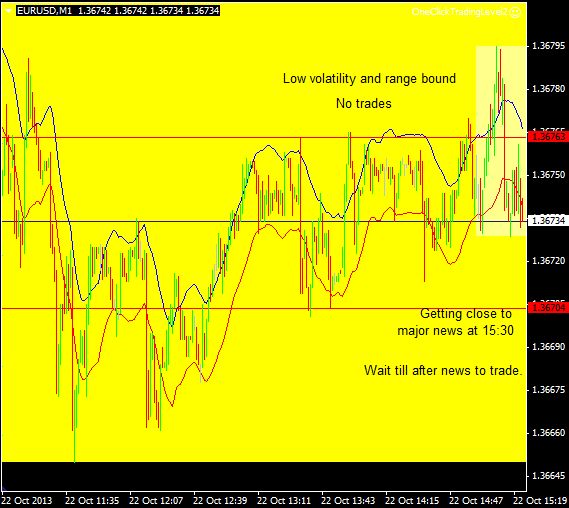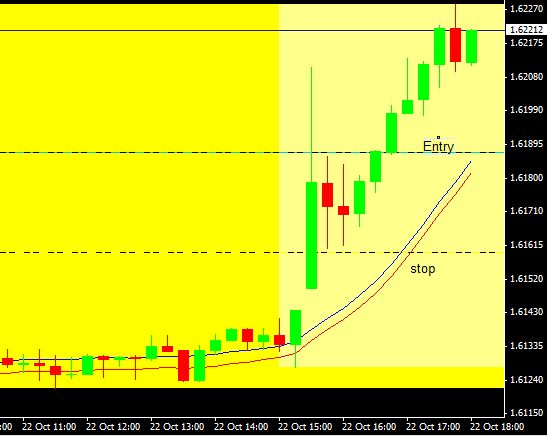Trading the News – EUR/USD and GBP/USD Day Trades
In a rare event, non-farm payroll data out of the US was released on Tuesday, October 22 due to the prior government shutdown. Non-farm payroll data is usually released on the first Friday of each month, at 8:30 AM EST.
Having a strategy for trading the non-farm payroll report should be in every forex trader’s arsenal, as it is one of the most volatile and potentially lucrative days we see. Realizing when not to trade around the news release is equally important though.
When Not to Trade
Regardless of if there is news or not, trading when there is very little volatility decreases the chances of a successful trade. If the pair you’re watching has only moved 20 pips all morning, it is going to be hard to snag a 10 or 15 pip profit. It’s best to sit out and wait for better opportunities.
Prior to major news releases the market is often fairly quiet, only presenting low-quality trade signals. That was the case before the non-farm payroll data on October 22.
Figure 1. EUR/USD 1-Minute Chart before Non-farm Payroll Data

I started watching the EUR/USD at about 14:00, and knew the data was due out at 15:30 (GMT+3:00). While trade signals were occurring, by looking at the overall structure of the price movements there were no high quality signals. A range developed prior to the news announcement, and choppy trading prior to the range didn’t provide a clear overall market direction which could be used to filter signals.
Patience is one of the greatest trading virtues. Anyone can make some winning trades, but it is the ability to avoid the urge to trade when conditions are not right that separate professionals from amateurs.
With no valid trade setups prior the non-farm payroll release, I focused my attention on the GBP/USD for the NFP release.
Trading the Non-Farm Payroll (NFP)
To trade the NPF report, I use the GBP/USD and a 15 minute chart. By using a 15-minute chart I am forced to wait at least 30 minutes for a trade signal to occur. During this time volatility will subside and I am less likely to incur slippage or get stuck in a very sharp move where my risk is unknown.
The basic strategy for trading the NFP report involves waiting for a consolidation after the initial wide-ranging bar the news releases causes. Once there is a consolidation, I trade the breakout from that consolidation.
The maximum stop is 30 pips, but can be less. If I am going long and there is a recent low to place my stop behind, I will do that. If I am going short, and there is a recent high to place my stop behind, I will do that. A typical stop is 20 to 30 pips for this trade.
I used a timed exit to get out of the trade, 4 hours after entry. A trailing stop can also be used as well. For example, if you are long, move your stop to below recent swing lows as they occur.
While the trade is not over yet, figure 2 shows the GBPUSD NFP trade from October 22.
A long trade is taken as the price breaks out of a consolidation (entry line marked) and a stop is placed below the recent low (stop line marked).
Figure 2. GBP/USD NFP Trade – 15-Minute Chart

While I use a timed exit, I will also place a profit target at 100, 125 or 150 pips (depending on overall market volatility). Since I don’t constantly monitor the position, this gets me out of the trade at a nice profit if the price runs aggressively while I am away from my screen.
So far the trade is showing about a 35 pip profit.
Trading the News Considerations
I utilize a news trading strategy, like the one above, only for major news releases, and if the news causes a strong initial price spike. This shows there is interest and a trend is likely to develop once the initial volatility subsides.
If I am stopped out twice in a row on a news trade, the price action is likely too choppy and the strategy is not utilized again that day.
Trades are never taken before the news release, only after the news release and only after the price has consolidated showing volatility has dropped and the market is about to choose its direction.